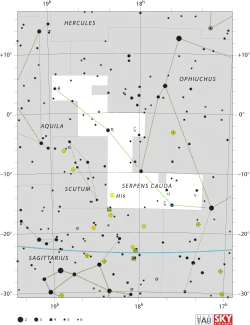Eta Serpentis
Eta Serpentis, Latinized from η Serpentis, is a star in the constellation Serpens. In particular, it lies in Serpens Cauda, the snake's tail. The star has an apparent visual magnitude of 3.260,[2] making it visible to the naked eye. Parallax measurements give a distance estimate of 60.5 light-years (18.5 parsecs) from the Earth.[1]
 | |
| Observation data Epoch J2000 Equinox J2000 | |
|---|---|
| Constellation | Serpens |
| Right ascension | 18h 21m 18.60056s[1] |
| Declination | −02° 53′ 55.7766″[1] |
| Apparent magnitude (V) | 3.260[2] |
| Characteristics | |
| Spectral type | K0 III-IV[3] |
| U−B color index | +0.643[2] |
| B−V color index | +0.940[2] |
| Astrometry | |
| Radial velocity (Rv) | +8.4[4] km/s |
| Proper motion (μ) | RA: −547.75[1] mas/yr Dec.: −701.42[1] mas/yr |
| Parallax (π) | 53.93 ± 0.18 mas[1] |
| Distance | 60.5 ± 0.2 ly (18.54 ± 0.06 pc) |
| Absolute magnitude (MV) | +1.87[5] |
| Details | |
| Mass | 2.0[6] M☉ |
| Radius | 5.897 ± 0.028[7] R☉ |
| Luminosity | 19 ± 1[8] L☉ |
| Surface gravity (log g) | 3.21[3] cgs |
| Temperature | 4,890[3] K |
| Metallicity [Fe/H] | −0.42[3] dex |
| Rotational velocity (v sin i) | 2.6[9] km/s |
| Other designations | |
| Database references | |
| SIMBAD | data |
This star is larger than the Sun, with twice the mass and almost six times the radius.[6][7] The spectrum matches a stellar classification of K0 III-IV,[3] with the luminosity class of III-IV corresponding to an evolved star that lies between the subgiant and giant stages. The expanded outer envelope star is radiating about 19 times the luminosity of the Sun at an effective temperature of 4,890 K.[3] At this temperature, it has an orange hue typical of a K-type star.[11] Eta Serpentis displays solar-like oscillations with a period of 0.09 of a day.[12]
Eta Serpentis was previously classified as a carbon star, which would have made it the brightest carbon star in the sky, although this classification was since found to be erroneous.[13]
Eta Serpentis is currently 1.6 light-years away from Gliese 710.
Name
In Chinese astronomy, the star is known as 天市左垣 (Tiān Shì Zuǒ Yuán), meaning 'Left Wall of Heavenly Market Enclosure'; the name refers to an asterism that represents eleven old states in China. The leftmost borderline of the enclosure consists of η Serpentis, δ Herculis, λ Herculis, μ Herculis, o Herculis, 112 Herculis, η Ophiuchi, ζ Aquilae, θ1 Serpentis, ν Ophiuchi and ξ Serpentis.[14] Consequently, the Chinese name for η Serpentis itself is 天市左垣八 (Tiān Shì Zuǒ Yuán bā, the Eighth Star of Left Wall of Heavenly Market Enclosure, representing the region of Donghai (東海, lit. meaning 'eastern sea'),[15][16]
References
- van Leeuwen, F. (November 2007), "Validation of the new Hipparcos reduction", Astronomy and Astrophysics, 474 (2): 653–664, arXiv:0708.1752, Bibcode:2007A&A...474..653V, doi:10.1051/0004-6361:20078357, S2CID 18759600
- Cousins, A. W. J. (1984), "Standardization of Broadband Photometry of Equatorial Standards", South African Astronomical Observatory Circulars, 8: 59, Bibcode:1984SAAOC...8...59C
- Frasca, A.; et al. (December 2009), "REM near-IR and optical photometric monitoring of pre-main sequence stars in Orion. Rotation periods and starspot parameters", Astronomy and Astrophysics, 508 (3): 1313–1330, arXiv:0911.0760, Bibcode:2009A&A...508.1313F, doi:10.1051/0004-6361/200913327, S2CID 118361131
- Wielen, R.; et al. (1999), "Sixth Catalogue of Fundamental Stars (FK6). Part I. Basic fundamental stars with direct solutions", Veroeffentlichungen des Astronomischen Rechen-Instituts Heidelberg, Astronomisches Rechen-Institut Heidelberg, 35 (35): 1, Bibcode:1999VeARI..35....1W
- Carney, Bruce W.; et al. (March 2008), "Rotation and Macroturbulence in Metal-Poor Field Red Giant and Red Horizontal Branch Stars", The Astronomical Journal, 135 (3): 892–906, arXiv:0711.4984, Bibcode:2008AJ....135..892C, doi:10.1088/0004-6256/135/3/892, S2CID 2756572
- Edvardsson, B. (January 1988), "Spectroscopic surface gravities and chemical compositions for 8 nearby single sub-giants", Astronomy and Astrophysics, 190 (1–2): 148–166, Bibcode:1988A&A...190..148E
- Mérand, A.; et al. (July 2010), "Interferometric radius and limb darkening of the asteroseismic red giant η Serpentis with the CHARA Array", Astronomy and Astrophysics, 517: A64, Bibcode:2010A&A...517A..64M, doi:10.1051/0004-6361/200912103
- Piau, L.; et al. (February 2011), "Surface convection and red-giant radius measurements", Astronomy and Astrophysics, 526: A100, arXiv:1010.3649, Bibcode:2011A&A...526A.100P, doi:10.1051/0004-6361/201014442, S2CID 118533297
- Massarotti, Alessandro; et al. (January 2008), "Rotational and Radial Velocities for a Sample of 761 HIPPARCOS Giants and the Role of Binarity", The Astronomical Journal, 135 (1): 209–231, Bibcode:2008AJ....135..209M, doi:10.1088/0004-6256/135/1/209, S2CID 121883397
- "eta Ser -- Variable Star", SIMBAD, Centre de Données astronomiques de Strasbourg, retrieved 2012-01-19
- "The Colour of Stars", Australia Telescope, Outreach and Education, Commonwealth Scientific and Industrial Research Organisation, December 21, 2004, archived from the original on 2012-03-18, retrieved 2012-01-16
- Tabur, V.; et al. (December 2010), "Period-luminosity relations of pulsating M giants in the solar neighbourhood and the Magellanic Clouds", Monthly Notices of the Royal Astronomical Society, 409 (2): 777–788, arXiv:1007.2974, Bibcode:2010MNRAS.409..777T, doi:10.1111/j.1365-2966.2010.17341.x, S2CID 118411237
- Antipova, L. I.; Boyarchuk, A. A. (2001). "The chemical composition of the red giant η Ser". Astronomy Reports. 45 (9): 700. Bibcode:2001ARep...45..700A. doi:10.1134/1.1398919. S2CID 62893990.
- (in Chinese) 中國星座神話, written by 陳久金. Published by 台灣書房出版有限公司, 2005, ISBN 978-986-7332-25-7.
- (in Chinese) AEEA (Activities of Exhibition and Education in Astronomy) 天文教育資訊網 2006 年 6 月 23 日
- (in Chinese) English-Chinese Glossary of Chinese Star Regions, Asterisms and Star Name Archived August 10, 2010, at the Wayback Machine, Hong Kong Space Museum. Accessed on line November 23, 2010.